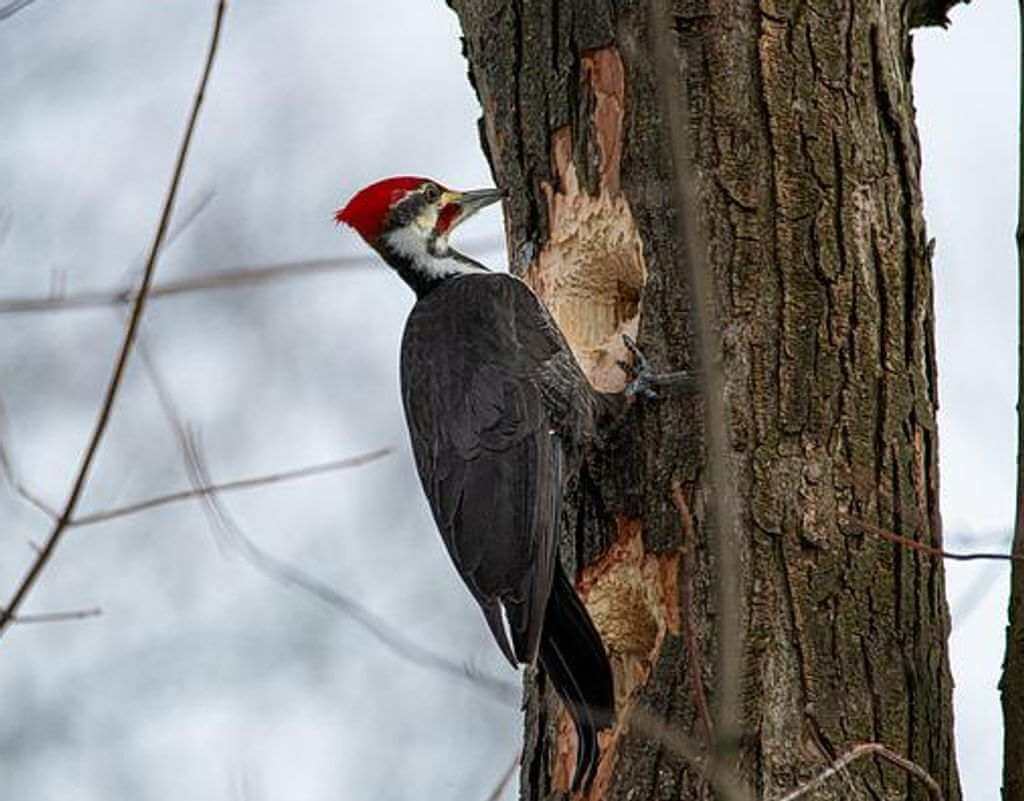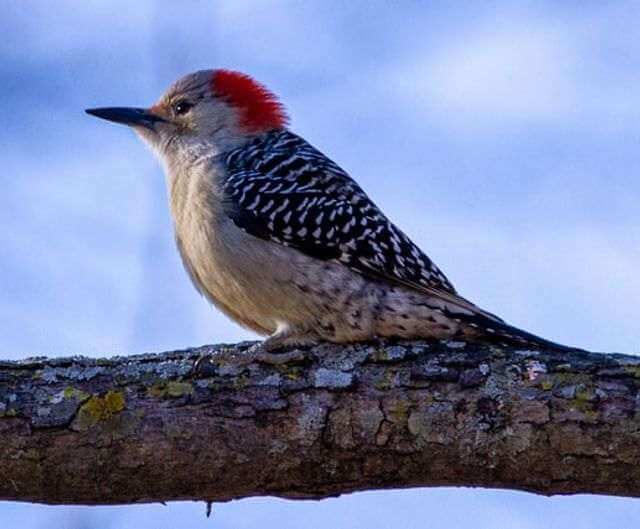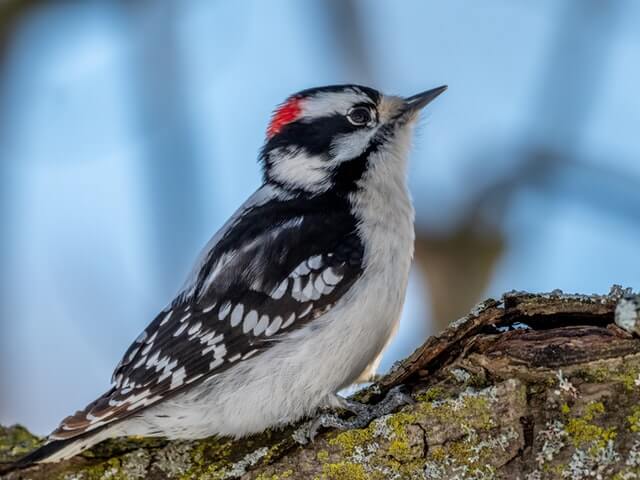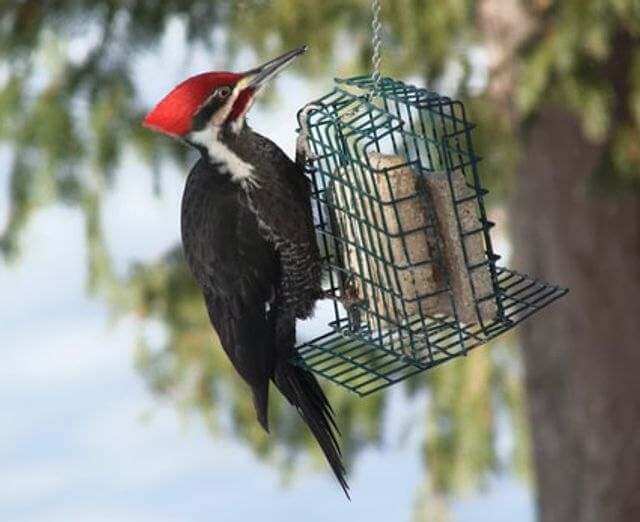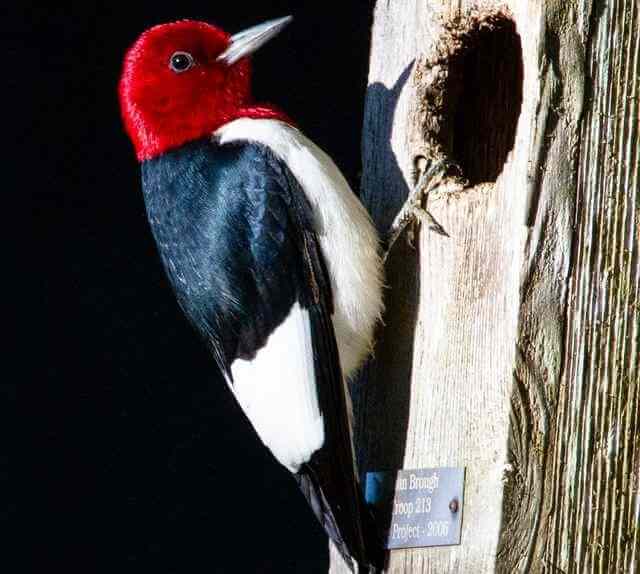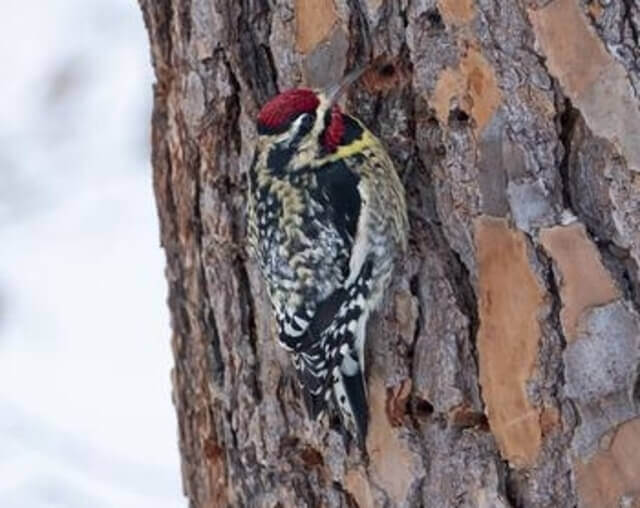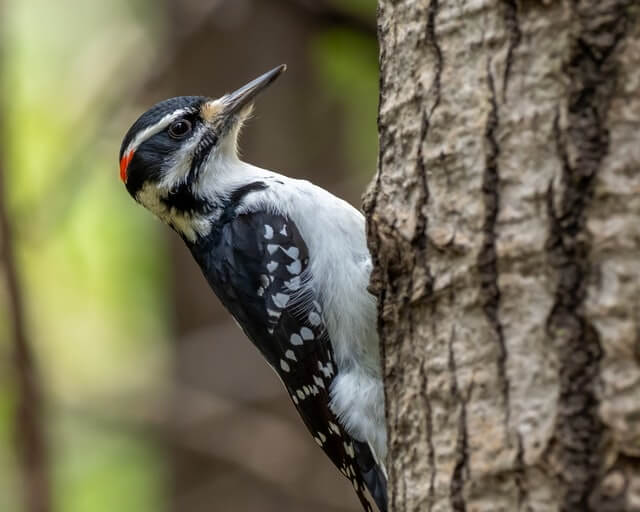Alabama is home to a diverse array of woodpecker species, each with its own unique characteristics and habitats. In this ultimate guide, we explore the nine most prominent woodpeckers found in Alabama. From the majestic Pileated Woodpecker to the diminutive Downy Woodpecker, discover the fascinating world of woodpeckers in the Heart of Dixie.
Table of Contents
Types of Woodpeckers in Alabama
Red-bellied Woodpecker
- Length: 9.5 in (24 cm)
- Weight: 2.0-3.2 oz. (56-90 g)
- Wingspan: 13.0-16.5 in (33-42 cm)
- Scientific Name: Melanerpes carolinus
- Frequency of Occurrence: 38.64% (Statistic by: eBird)
- Where To Find Them: These birds are commonly seen in the northern part of the state, near the Tennessee border. They can also be found in the central part of Alabama, as well as in the southern part of the state near Mobile. The red-bellied woodpecker is not typically found in the highlands of Alabama, but can be seen in some areas around Birmingham.
- How to Attract: If you would like to attract these birds to your yard, there are a few things you can do. First, try planting some trees and shrubs that will provide them with food and shelter. The Red-bellied Woodpecker likes to eat insects, so trees that have lots of bark and branches are ideal. You can also provide them with a bird feeder that offers suet or insects. Finally, make sure your yard is well landscaped and has plenty of trees, shrubs, and other hiding places.
Description: The Red-bellied Woodpecker (Melanerpes carolinus) is a medium-sized woodpecker found in North America. They range from Southern Canada to Northern Mexico, and can be found in a variety of habitats including forests, woodlands, parks, and gardens. They forage on the ground or in trees for insects, which make up the majority of their diet. These woodpeckers also eat fruits and nuts. They build their nests in tree cavities, often using abandoned birdhouses or natural tree hollows. A typical clutch contains 4-5 eggs.
Related Post: How to Attract Red-bellied Woodpeckers to your Yard?
Downy Woodpecker
- Length: 5.5-6.7 in (14-17 cm)
- Weight: 0.7-1.0 oz. (21-28 g)
- Wingspan: 9.8-11.8 in (25-30 cm)
- Scientific Name: Picoides pubescens
- Frequency of Occurrence: 27.06%
- Where To Find Them: In Alabama, they are most common in the northeast and north-central parts of the state. They can also be seen in the southern part of the state near Mobile and along the Gulf Coast.
- How to Attract: They are attracted to areas with plenty of trees and other vegetation, so if you want to attract them to your yard, you’ll need to provide some of that for them. One way to do this is by planting tall trees and shrubs, as they will use these for nesting and foraging. You can also provide a bird feeder stocked with suet or black oil sunflower seeds, as these are two of the downy woodpecker’s favorite foods. If you keep your yard well-maintained and provide the necessary food and shelter, you should be able to enjoy the sight of these beautiful birds in your backyard for years to come!
Description: The Downy Woodpecker is the smallest woodpecker in North America. It is about six inches long and has a black back, white belly, and a red head. The Downy Woodpecker can be found in forests, orchards, and parks throughout most of North America. This woodpecker feeds on insects that it finds by pecking on tree bark. It also eats berries and seeds. The Downy Woodpecker builds its nest by boring a hole in a dead tree or piece of wood. Up to six eggs are laid in the nest, which is incubated by both the male and female bird. The young Downy Woodpeckers leave the nest after about two weeks.
Related Post: How to Attract Downy Woodpeckers to Your Yard? (Easy!)
Pileated Woodpecker
- Length: 15.8-19.3 in (40-49 cm)
- Weight: 8.8-12.3 oz. (250-350 g)
- Wingspan: 26.0-29.5 in (66-75 cm)
- Scientific Name: Dryocopus pileatus
- Frequency of Occurrence: 9.19%
- Where To Find Them: Pileated woodpeckers can be found in the eastern part of the state, typically in the Appalachian Mountains.
- How To Attract: One way to attract these woodpeckers is to provide them with a food source. Pileated Woodpeckers primarily eat insects, so providing a bird feeder that offers a variety of insects will help attract them. You can also plant trees and shrubs that offer nuts, berries, and other insect-rich foods. Another key factor in attracting Pileated Woodpeckers is to provide them with a suitable nesting site.
Description: The pileated woodpecker is the second-largest woodpecker in North America, measuring up to 20 inches in length and weighing up to 350 grams. This striking bird can be identified by its black and white plumage, red crest, and characteristic “yawn” call. The pileated woodpecker ranges from southern Canada to northern Mexico, inhabiting deciduous forests and mixed woodlands. This adaptable bird feeds on a variety of insects, including beetles, ants, termites, and grubs, as well as fruit and nuts. Pileated woodpeckers are monogamous birds that build their nests in tree cavities. Up to four eggs may be laid per clutch.
Related Post: How to Attract Pileated Woodpeckers to your Yard (Fast)
Northern Flicker
- Length: 11.0-12.0 in (28-31 cm)
- Weight: 3.9-5.6 oz. (110-160 g)
- Wingspan: 16.5-20.0 in (42-51 cm)
- Scientific Name: Colaptes auratus
- Frequency of Occurrence: 9.11%
- Where To Find Them: The Northern Flicker can be found in many different areas or locations in Alabama. They can be found in the eastern and southeastern parts of the state, as well as in the north-central area. They are also commonly found in the Birmingham area.
- How To Attract: They are easily attracted to yards that have a food source, such as suet or sunflower seeds. You can also provide them with a water source by adding a birdbath or saucer of water to your yard. If you want to attract Northern Flickers to your yard, make sure you provide a safe place for them to nest by putting up a nesting box.
Description: Northern flickers are common throughout most of the United States and southern Canada. They live in a variety of habitats, including open woodlands, forests, suburbs, and even cities. Northern flickers eat mainly insects, but they also eat berries and seeds. Male and female northern flickers build a nest together in a tree cavity or abandoned woodpecker hole. The female lays 4-7 eggs, which the male incubates for 11-12 days. Once the eggs hatch, both parents help feed the young birds.
Related Post: How to Attract Northern Flickers to your Backyard (Easy)
Red-headed Woodpecker
- Length: 7.5-9.1 in (19-23 cm)
- Weight: 2.0-3.2 oz. (56-91 g)
- Wingspan: 16.5 in (42 cm)
- Scientific Name: Melanerpes erythrocephalus
- Frequency of Occurrence: 7.71%
- Where To Find Them: In Alabama, they can be found in the Tennessee Valley, the Black Belt, and the Gulf Coast.
- How to Attract: If you want to attract these beautiful woodpeckers to your yard, there are a few things you can do. First, provide them with a food source. Red-headed woodpeckers love insects, so try to put out a feeder that attracts lots of bugs. You can also plant insect-rich plants in your garden, such as borage, butterfly weed, or goldenrod. Second, create some nesting habitat.
Description: The Red-headed Woodpecker is a medium-sized woodpecker found in North America. It ranges from southern Canada to northern Mexico, and as far east as Florida and Texas. The preferred habitat of the Red-headed Woodpecker is open woodlands, but it can also be found in parks, orchards, and suburban areas. These birds forage on the ground or in trees, eating insects, fruit, seeds, and nuts. They build their nests in trees, often using an abandoned nest of another bird. The female lays 3-6 eggs, which are incubated by both parents for about two weeks. The young birds stay with their parents for another two weeks before leaving the nest.
Related Post: Interesting Red-Headed Woodpecker Facts (Explained)
Yellow-bellied Sapsucker
- Length: 7.1-8.7 in (18-22 cm)
- Weight: 1.5-1.9 oz. (43-55 g)
- Wingspan: 13.4-15.8 in (34-40 cm)
- Frequency of Occurrence: 6.09%
- Where To Find Them: The Yellow-bellied Sapsucker is a migratory bird that can be found in Alabama during the winter. Some of the best places to look for them in Alabama include Cheaha State Park, DeSoto National Forest, and Gulf Shores National Seashore.
- How to Attract: They can be attracted to your yard by putting up a suet feeder and providing water. The best way to do this is by putting out a small dish or bird bath and filling it with fresh water every day. You can also attract them by planting trees and shrubs that they like to eat, such as maples, birches, and dogwoods.
Description: The Yellow-bellied Sapsucker is a migratory species found in North America. They are typically found in hardwood and coniferous forests, but can also be found in parks, orchards, and residential areas. They forage for insects on the trunks and branches of trees, as well as on the ground. Furthermore, they build their nests in cavities in trees, often using abandoned woodpecker holes. The female lays 4-7 eggs, which both parents help to incubate. The young birds fledge about 2 months after hatching.
Related Post: 16 Interesting Sapsucker Facts Revealed!
Hairy Woodpecker
- Length: 7.1-10.2 in (18-26 cm)
- Weight: 1.4-3.4 oz. (40-95 g)
- Wingspan: 13.0-16.1 in (33-41 cm)
- Scientific Name: Picoides villosus
- Frequency of Occurrence: 3.24%
- Where To Find Them: Hairy Woodpeckers can be found in many areas in Alabama. One place to find them is around Dauphin Island, where they can be seen near the water’s edge. They can also be found in the pine forests of the state and in deciduous woods. In winter, they may be seen in open fields or along roadsides.
- How to Attract: You can attract them to your yard by providing a food source and someplace for them to nest. You can provide a food source for hairy woodpeckers by putting out a suet feeder or placing an insect-rich garden near their nesting area. Be sure to keep the area free of pesticides and other chemicals that could be harmful to the birds. Hairy woodpeckers also need somewhere to nest. They like tall trees with dead limbs where they can excavate a hole for their nest. If you don’t have any tall trees in your yard, you can provide artificial nesting boxes for the birds.
Description: The Hairy Woodpecker is a small-sized woodpecker that ranges from 7 to 10″ inches in length and weighs between 1.5 and 3.5 ounces. This species can be found in a variety of habitats, including coniferous forests, mixed woodland, deciduous forests, and even parks and gardens. The diet of the Hairy Woodpecker consists mainly of insects, but they will also eat fruit, seeds, and nuts. These birds typically nest in tree cavities, but they will also use abandoned bird nests or man-made structures.
Red-cockaded Woodpecker
- Length: 7.9-9.1 in (20-23 cm)
- Weight: 1.5-1.8 oz. (42-52 g)
- Wingspan: 14.2 in (36 cm)
- Scientific Name: Picoides borealis
- Frequency of Occurrence: 0.1967%
- Where To Find Them: Red-cockaded woodpeckers can be found in a few different areas or locations in Alabama, including the Conecuh National Forest, the Talladega National Forest, and the Tuskegee National Forest. They can also be seen in some parts of the Black Belt region of the state, as well as around Mobile Bay.
- How to Attract: There are several things you can do to attract Red-cockaded Woodpeckers to your yard. One is to plant large trees that have bark crevices. You can also provide artificial nesting boxes and dead trees for them to use. Additionally, you can create a feeding area with a variety of food sources, such as suet, peanut butter, and bird seed. If you provide the right habitat, you may be able to attract Red-cockaded Woodpeckers to your yard.
Description: The Red-cockaded Woodpecker is a federally endangered species that inhabits the longleaf pine forests of the southeastern United States. This woodpecker has a range that extends from eastern Texas to central Florida, and as far north as Virginia. The Red-cockaded Woodpecker prefers open, mature pine forests with a dense understory for nesting and foraging. These woodpeckers feed mainly on insects, but also consume nuts, berries, and sap from pine trees. Male Red-cockaded Woodpeckers excavate cavities in living pine trees to nest in, while females lay their eggs in previously excavated cavities.
Ivory-billed Woodpecker
- Length: 18.1-20.1 in (46-51 cm)
- Weight: 15.9-20.1 oz (450-570 g)
- Wingspan: 29.9-31.5 in (76-80 cm)
- Scientific Name: Campephilus principalis
- Frequency of Occurrence: 0.0004%
- Where To Find Them: There are several locations in Alabama where the bird could potentially be found, including the Black Warrior River Basin, the Tombigbee River Basin, and the Conecuh National Forest.
- How to Attract: First, make sure you have a large tree with a lot of dead branches that the ivory-billed woodpecker can use for nesting. You can also hang a feeder filled with suet or peanuts in your yard. The birds will be attracted to the feeder and may stay for a while. Finally, make sure you keep your yard clean and free of debris, so the birds will feel safe and comfortable there.
Description: The Ivory-billed Woodpecker (Campephilus principalis) is a large woodpecker that is found in eastern North America. It is the largest woodpecker in the United States and Canada. The Ivory-billed Woodpecker inhabits bottomland hardwood forests and cypress swamps in the southeastern United States. In winter, it may also be found in pine forests in the southern United States. This woodpecker feeds mainly on insects, but also eats fruit, nuts, and seeds.
Related Post: 38 Most Common Birds in Alabama (with Photos, ID & Info)

